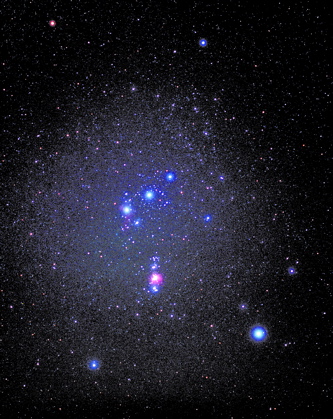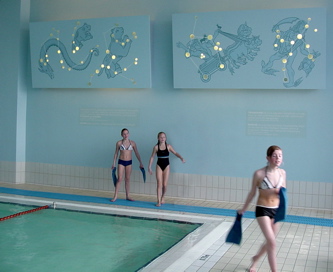In the swimming pool hall, in Grafarvogur, Reykjavík, Iceland.

Cassiopeia and Cepheus
Pegasus, Andromedra and Triangulum

Pegasus, Andromedra and Triangulum

Texts for each image/board
A relevant text (the myth of each sign) is placed on the wall beneath each image.
Stories from ancient times
The text is based on (taken from?) an excerpt from the catasterism texts by the Greek scholar and poet Eratosthenes, born 275 B.C. In this text Eratosthenes considers the myths of the astronomologial signs.
Around the age of thirty he moved from Athena to Alexandria, the latter being at the time the hot spot of the arts and science and where re-examination of ancient wisdom took place. In his writing on the star signs, Eratosthenes frequently quotes the poet Hesiod, who lived ca. 700 B.C. But the most ancient Greek references to the star signs, known to man, are to be found in Homer’s Iliad and Odyssey, from 9th century B.C.

Orion
A starry sky 2003.
Photo: Snævarr Guðmundsson
Concept and execution
Concept
I chose 16 astrological signs, pertaining to the northern hemisphere. The basis of the concept was the expanse – expanse in the context of distance in time and space; of the sky and the stars, with reference to contemporary literature on astronomy and to scholars and researchers throughout the ages.
Execution
The execution of the artwork was dictated by the concept as a whole, adapting the work to the swimming pool hall and its guests. Photos were blown-up, mixed (morphed) and redeveloped. Colors were chosen in accordance with the (topical) hues of the water and the image of a far-away expanse. Stars of glass (cast in molds of clay) were placed in holes/cut-outs in the hardboard and backlit by a light-source from behind. The walls of the swimming pool hall were painted in the dominant color of the work and a relevant text placed beneath each board.

The sign of Orion
The drawing/design was borrowed from a 15th century book on astronomy. The artist is Erhard Ratholt, a prolific and brilliant master of printing who had his heyday at the beginning of the Renaissance. He was born in Augsburg but lived in Venice from 1475-1486, and excelled in his craft. He oversaw the printing of many excellent books in the refined Venetian style. Ratholt did the woodcarvings in question for the re-publication and printing of the work Poeticon Astronomicon that dealt with the myths and astrological signs by the Latin astronomer Hyginus who lived in the second century A.D. The graphics by Ratholt in the book, from the year 1482, are said to be the first illustrations of the myths of astronomical signs, printed in a book.
The sign of Orion
A drawing from a contemporary literature on astronomy. 
Orion and Canis Major on working stage 2002
Canis Minor, Canis Major and Orion
Draco, Ursa Minor and Ursa Major
The work in the swimming pool hall ... but the text still missing.

Draco, Ursa Minor and Ursa Major
Auriga and Perseus.
The work in the swimming pool hall ... with the text on the wall.
Text: BÓ.
Based on Star Myths of the Greeks and Romans, Theony Condos, Phanes Press1997 (www.phanes.com)
Translation: G.S.



